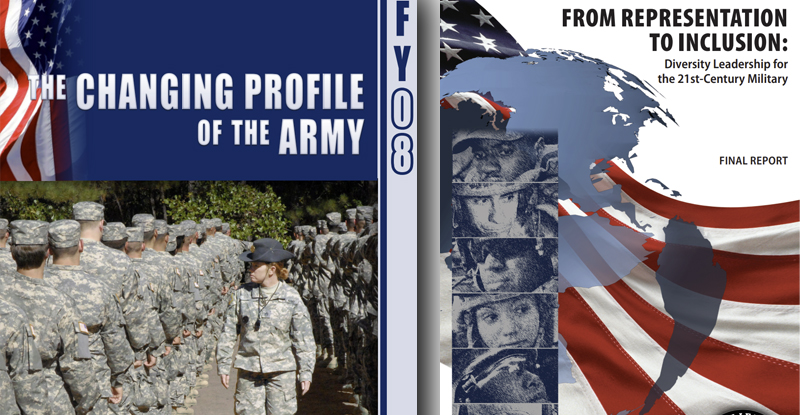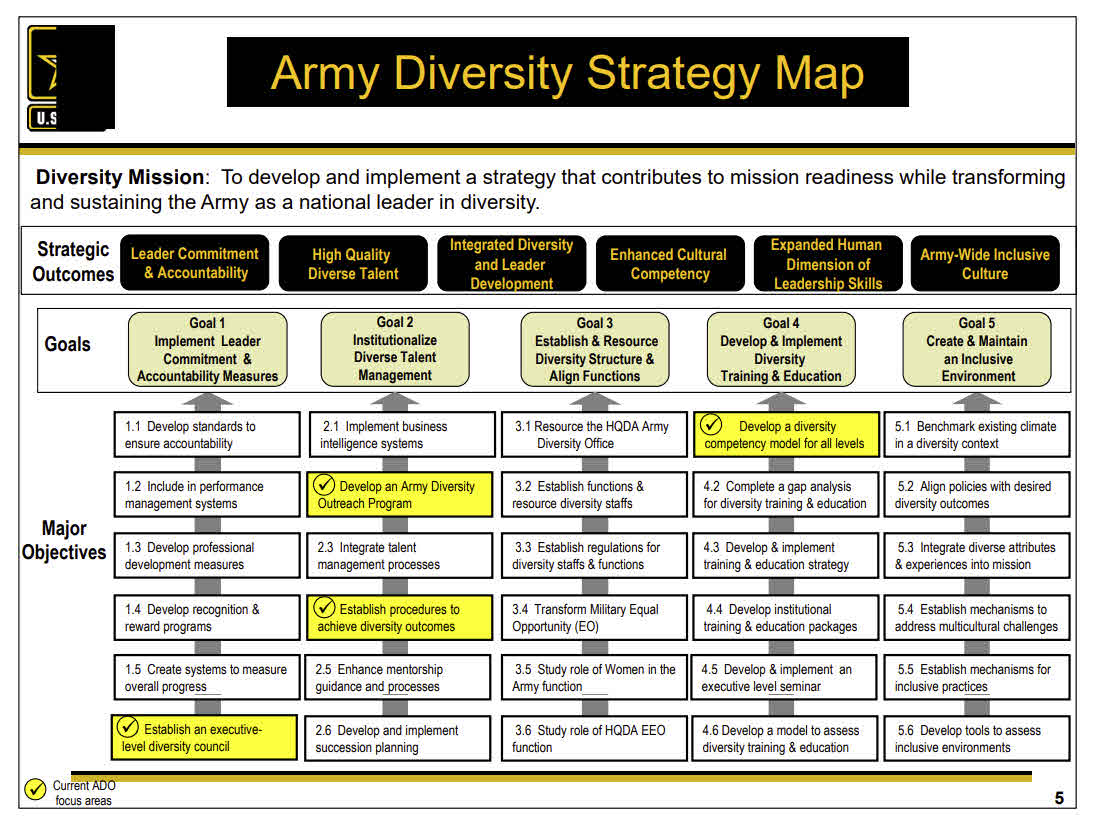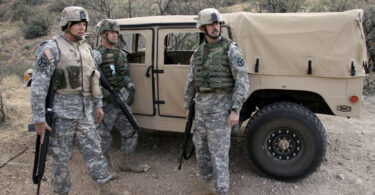By Will Thibeau, Army Ranger veteran
First published on Tom Klingenstein’s website. His Note: Perhaps more explicitly than any other major institution, the Armed Forces operate on the principle of group quotas: proportional outcome for identity groups on the basis of race and sex. When lives (and the very security of our country) are at stake, the burden of proof is on Will Thibeau, an Army Ranger veteran and director of the American Military Project at the Center for the American Way of Life, examines in detail each point of the military’s most extensive case for a diversity-centric force, and finds each severely lacking.
PART ONE | PART TWO | PART THREE | PART FOUR
Part II of Identity in the Trenches: The Fatal Impact of Diversity, Equity, and Inclusion on U.S. Military Readiness.
In 2008 — under the Republican administration of George W. Bush — the Army Diversity Task Force published a final report which outlined, in its second chapter, the seven reasons why “diversity” must become a primary consideration in military policy. Though it is now more than 15 years old, the 2008 report remains the most comprehensive and telling explanation of the logic of the woke military.
Later efforts — including Hicks’s Strategic Management Plan, the 2020 final report of the DoD Board on Diversity and Inclusion, and the 2011 report of the Military Leadership Diversity Commission — focus only on how to remake the military in the image of the public, treating the why as a settled question.
Thus, the 2008 report is still our best resource for understanding the thinking behind quotas — and, presumably, the strongest possible case for imposing them on the military. Yet each of its seven points disintegrates under even the briefest scrutiny.
- “Accessions. Talent is a distinguishing factor in organizational performance. As America becomes more diverse, our talent is increasingly distributed across that same diversity. The Army must understand America’s diverse citizenry and be able to recruit across that diversity to bring in the talented people we need. Valued, inspired employees working in an inclusive environment will help deliver a positive message to prospective Soldiers, Civilians, and their influencers.”
The Army’s assumption is that demographic change will make race-based recruitment practices a necessity. That is, as the white population (historically overrepresented in uniform) declines nationwide, intentional outreach to minority groups will be the only way to sustain the necessary troop levels. DEI (we are told) will prevent our force numbers from falling off a demographic cliff.
This promise is belied by the facts of recent history. Last year, the Army fell short of its recruiting target by a full 10,000 enlistees, following a 2022 shortfall of 15,000. This brought the manpower of the largest and oldest of our uniformed services to the lowest level it’s seen since the start of World War II. The other services all report similar shortfalls — and have been for years. The shortfall across all services for 2023 totalled at about 41,000. In 2024, there are fewer Americans serving in uniform than any year since 1940.
Despite failing to deliver the promised benefit, the DEI recruitment strategy has come at massive costs to our military, both financial and operation.
In 2022, the DoD asked for $66 million for spending on DEI initiatives, followed by $86 million in 2023. This year, it is requesting $114 million.
While they are pumping all this money into DEI, the military branches are continually lowering their standards for admittance. In June 2022, the Army gutted the requirement for potential recruits to have a GED or equivalent; the Navy followed suit months after.
Similar drop-offs can be observed in physical fitness and other crucial metrics. The promises of 2008 notwithstanding, the effect of DoD’s diversity-centric recruitment strategy has been fewer enlistees, at lower levels of competency, at demonstrably higher cost.
- “Personnel Processes. Attention to organizational diversity principles and practices creates in leaders an appreciation of the power of diverse contributions from inspired employees. This appreciation leads to personnel systems and processes for managing talent that ensure balanced opportunities and contribute to a high performance climate by enhancing individual capabilities.”
At least since the Vietnam War, the Pentagon has gone to great lengths to ensure that racial dynamics will be accounted for in management practices.
Established in 1971, the Defense Equal Opportunity Management Institute’s initial mandate was to address racial tensions and promote equal opportunity within the U.S. military.
In 1979, it was reorganized to reflect its expanded mission beyond race relations to include gender, religion, national origin, and other areas of American diversity.
In 2018, DEOMI embarked on a further mission expansion to become the DoD Center of Excellence (CoE) for human relations, encompassing MEO, EEO, Diversity and Inclusion (D&I), and Harassment Prevention.
In 2020, Acting SecDef Christopher C. Miller — a Trump appointee — codified DEOMI’s expanded mission in a memorandum directing the establishment of a Diversity & Inclusion Center for Excellence at DEOMI to develop and train DoD-wide curriculum on diversity, inclusion, and cultural awareness.
In 2022, the Biden administration established the new Defense Advisory Committee on Diversity and Inclusion, an additional entity to make even more recommendations to the Pentagon about diversity.
Again, the proof is in the pudding.
In practice, these measures do nothing but inject tension into the military ranks. They are profoundly counterproductive, ensuring by their very existence that race will be a major factor in every aspect of personnel management.
- “Education and Training. The Army has a strong incentive for rank and file diversity education and training—most of our employees are likely to face cultural challenges through conflict or a multitude of other missions abroad. However, cultural understanding begins at home. The Army’s future demographics will bring new language and cultural challenges within our own ranks. Understanding of our own cultural, personal, and other differences through training, education, and similar development opportunities will create in us a proclivity for understanding others, whether it be for a deployment mission or for recruiting a future generation.”
In essence, the Pentagon hopes that the injection of new cultural dynamics into the ranks will compel service members to broaden their horizons: that “new language and cultural challenges” will become opportunities for growth for individual troops and for the services at large. In practice, the evidence suggests such “education” efforts are actually detrimental to the culture and effectiveness of our Armed Forces.
In 2021, Sen. Tom Cotton (R-AR) and Rep. Dan Crenshaw (R-TX) established a website where members of the U.S. military could anonymously report incidents of DEI overreach within their branches.
One Marine wrote that his unit’s “mandatory military history training was replaced with training on police brutality, white privilege and systemic racism.”
In another incident, an airman reported that his unit was forced to conduct a “privilege walk” where troops separated themselves by race and gender to talk about their experiences with privilege.
These are particularly egregious examples, but this kind of thinking has found its way into the vast majority of military education and has caused disruptions all across the board.
Far from making our military stronger, this new educational focus leads to distrust and dissension in the ranks, and it detracts valuable time, resources, and energy from the actually essential tasks of military training.
Would it not be better for troops to learn about the foundations of the institutions in which they serve, or to undergo additional skills training in their jobs, than to be lectured on the political perspective of the group quota regime?
And how can we expect soldiers to put their lives on the line for one another in combat when we divide them along racial lines in training?
- “National Implications. The Army draws its people from a diverse America – a nation that continues to evolve demographically. The Army defends and serves that same diverse population. Our understanding of America’s diversity will create new opportunities to influence diverse communities, support challenges related to youth preparation, and establish a brand that positively impacts the Army’s human capital strategy. As our Nation evolves demographically, the Army must be able to attract and retain highly capable people from diverse backgrounds.”
Yes, America is a diverse nation, and there is nothing wrong with developing a public relations strategy that appreciates this fact. It is a great leap, however, from this lofty rhetoric to the DoD’s actual practice of imposing percentage-based composition goals for these “diverse” communities.
This is what the Armed Forces’ diversity policy has been in practice: group quotas. This means active discrimination against recruits and service members not considered “diverse,” and an unfair advantage afforded to those who are. This is both a moral failure to “serve that same diverse population” as promised, and a reduction of military excellence to a second-grade concern.
- “Global Engagement. The anticipated nature of future global engagements calls for a diverse Army prepared for the human dimension of conflict. Due to current and future security environments, there is a need for a culturally astute and adaptive Army, capable of responding to American interests within any environment. A highly successful, long-term organizational diversity effort will give the Army an opportunity to become a national leader in diversity. Accomplishing this task will make a powerful statement to our workforce and the Nation. Success in understanding our internal cultural and other differences will create a predisposition for respecting differences that extends to preparation for global operations. Developing an appreciation for foreign cultures before appreciating our own cultures is inherently difficult. However, our internal success will enhance our ability to go beyond our own differences, and become more receptive to cultures of others with whom we may interact.”
The United States military exists to defend the United States of America — and, when necessary, to fight and win her wars. American service members must be able and willing to defend the people and Constitution of the United States against all enemies foreign and domestic. No other consideration is valuable or welcome in the process.
One potential end state of this muddled text is the demand that the US Military expand military service to all persons in the United States, regardless of legal status.
Senator Dick Durbin (D-IL), recently called for as much on the Senate floor, offering it as a potential solution to the DEI recruiting crisis:
“Do you know what the recruiting numbers are at the Army, Navy, and the Air Force? They can’t reach their quotas each month. They can’t find enough people to join our military forces. And there are those who are undocumented who want the chance to serve and risk their lives for this country. Should we give them a chance? I think we should.”
Of course, understanding our allies and our enemies is invaluable in both war and peace. If this understanding comes at the cost of the de-Americanization of our own Armed Forces, however, it will be the ultimate Pyrrhic victory. Cultural competency is not, in itself, a negative. When it is used as a justification for race-conscious recruitment, however, it must be swiftly and decisively dismissed.
- “Retention. From a diversity perspective, recruiting and retention prosper from the same inclusive environment. Valued employees who are inspired, fully engaged, and developing professionally in an environment of opportunity tend to stay and encourage others to stay.”
Training and initiatives that prevent discrimination and harassment do more than enough to foster an environment in which people want to work. Military diversity initiatives are having the opposite effect.
Internal Army data shows the share of white recruits has declined every year since 2018 to its lowest share in recorded history.
Even more stunning, Blue Star Families reported that more than one-third of active-duty military families would not recommend their children serve in the military.
In the critical cohort of American veterans, who produce 80% of servicemembers, over one-third name politicized military leadership as the reason they would not want family members to serve.
Quite simply, diversity initiatives are not working to diversify the fighting ranks; if anything, they have contributed to the political environment that is depressing a national ethic of service.
- “Performance. High performing organizations are made up of high performing people. After we recruit America’s talent, we can sustain high performing organizations by understanding the people we are leading and taking advantage of the diverse talents, skills, and attributes that derive from their backgrounds and experiences. Integration of individual talents into mission accomplishment in one area can lead to motivated personnel who perform better in other areas.”
In implementing various diversity initiatives, the military bears the burden of proof to show that each initiative would improve the lethality and readiness of its formations. In a September 2023 hearing in front of the House Armed Services Subcommittee on Military Personnel — 15 years after the publication of this report — no senior personnel officer was able to provide a single piece of authoritative research to prove the case.
In fact, the idea that group quotas will lead to a higher-performing military can be disproven by simple logic, even in the conspicuous absence of evidence.
If innate characteristics like race and sex are allowed to determine any part of personnel processes, then merit will be, at best, a secondary consideration.
So long as “diversity” remains a goal in itself, there is no guarantee that the best person is picked for any job.
We can either have a military maximized for skill and qualification, or we can have one organized by barely veiled group quotas; we cannot have both. Here, more than in any other field, merit is literally a matter of life and death.
If, as the DoD leadership itself claims, the goal is to create the best possible Armed Forces, capable of serving their mission as effectively and efficiently as possible, then there is only one way to achieve it: by selecting and training the best of the best, on considerations of merit alone.
Anything else imperils not just the lethality of our forces, but the integrity of our institutions, the morale of our troops, and the safety of the republic they are sworn to defend.
First published on Tom Klingenstein’s Website
2008 The Changing Profile of the Army (pdf)
2010 US Army diversity slides (pdf)









Leave a Comment